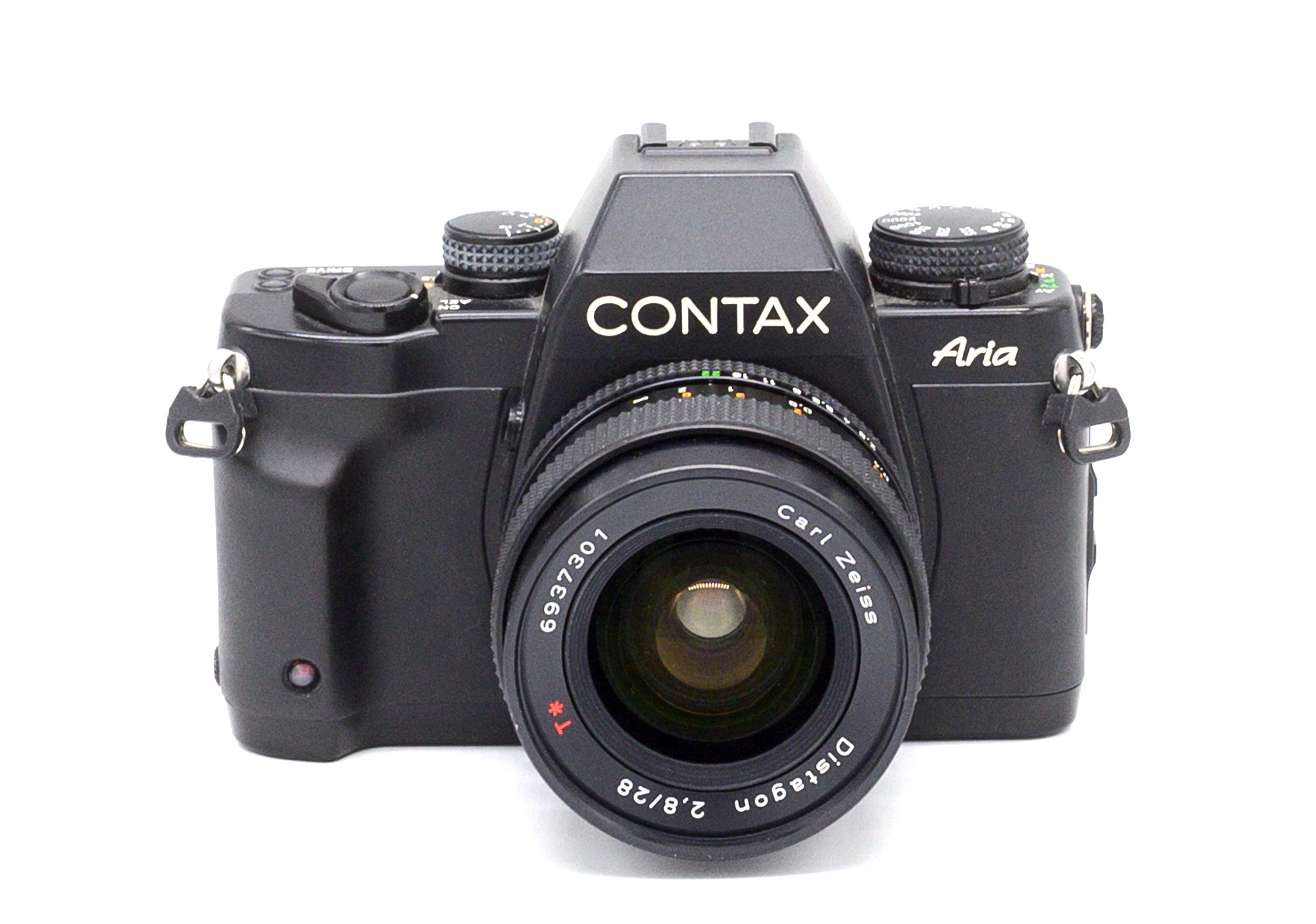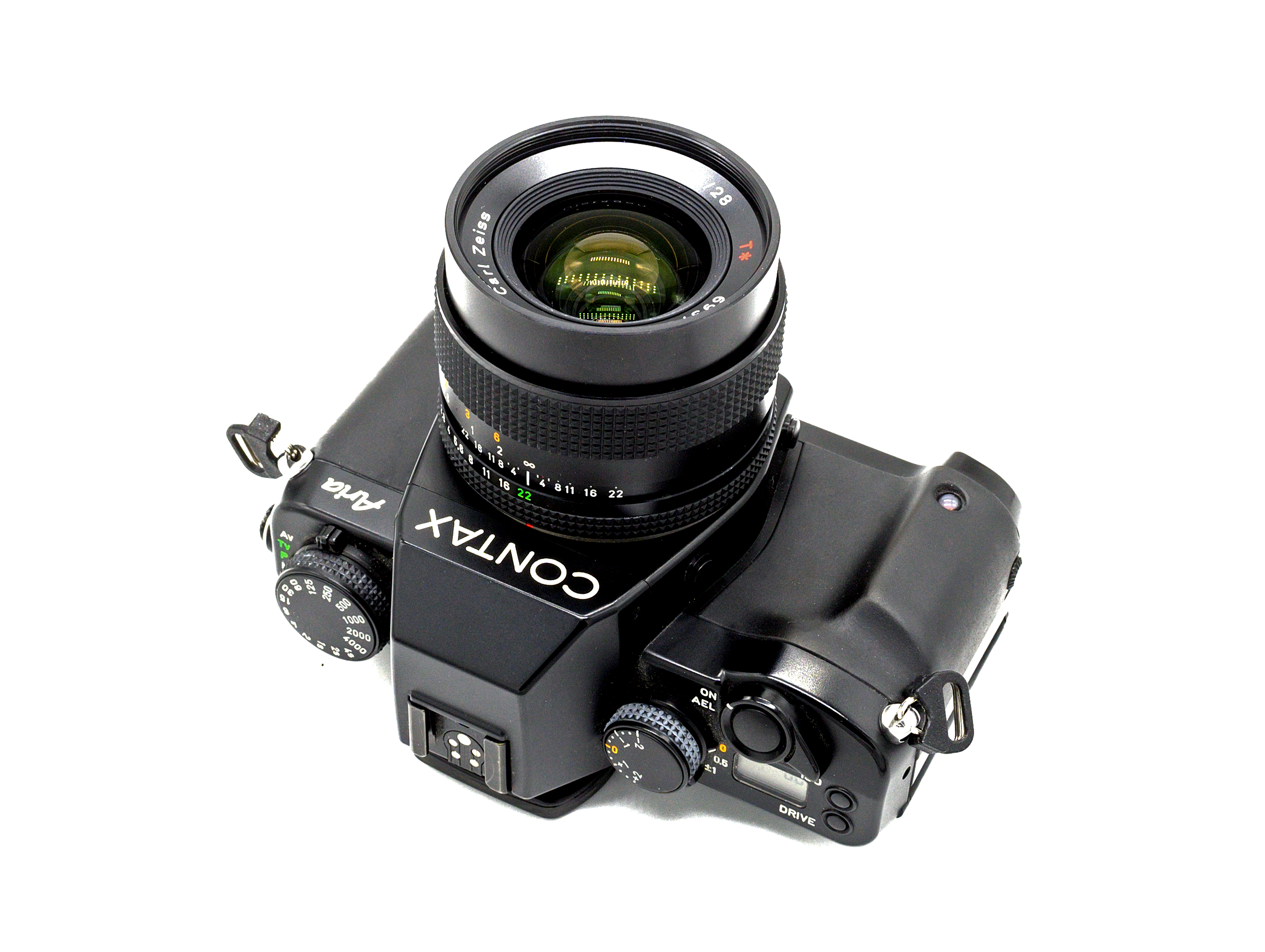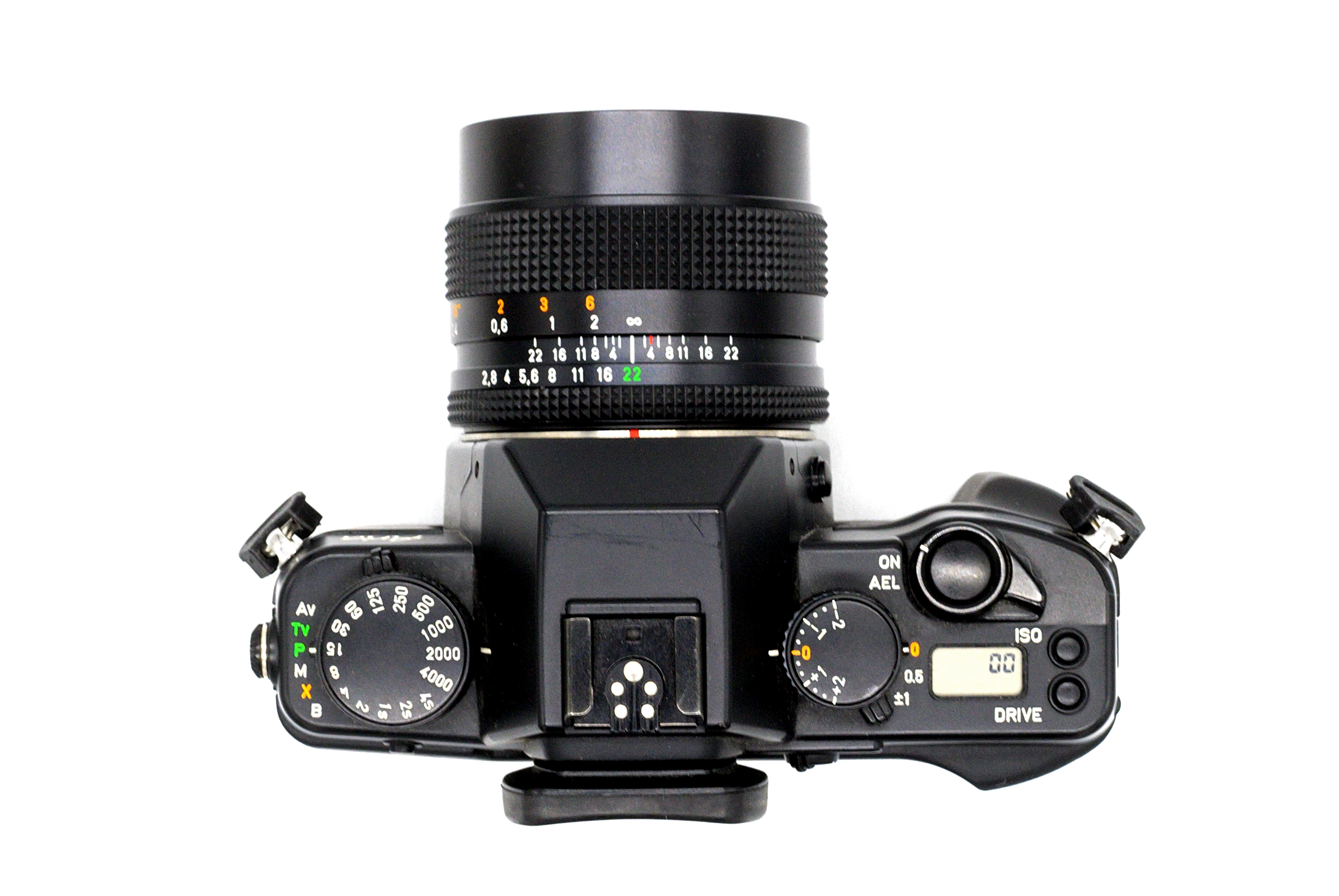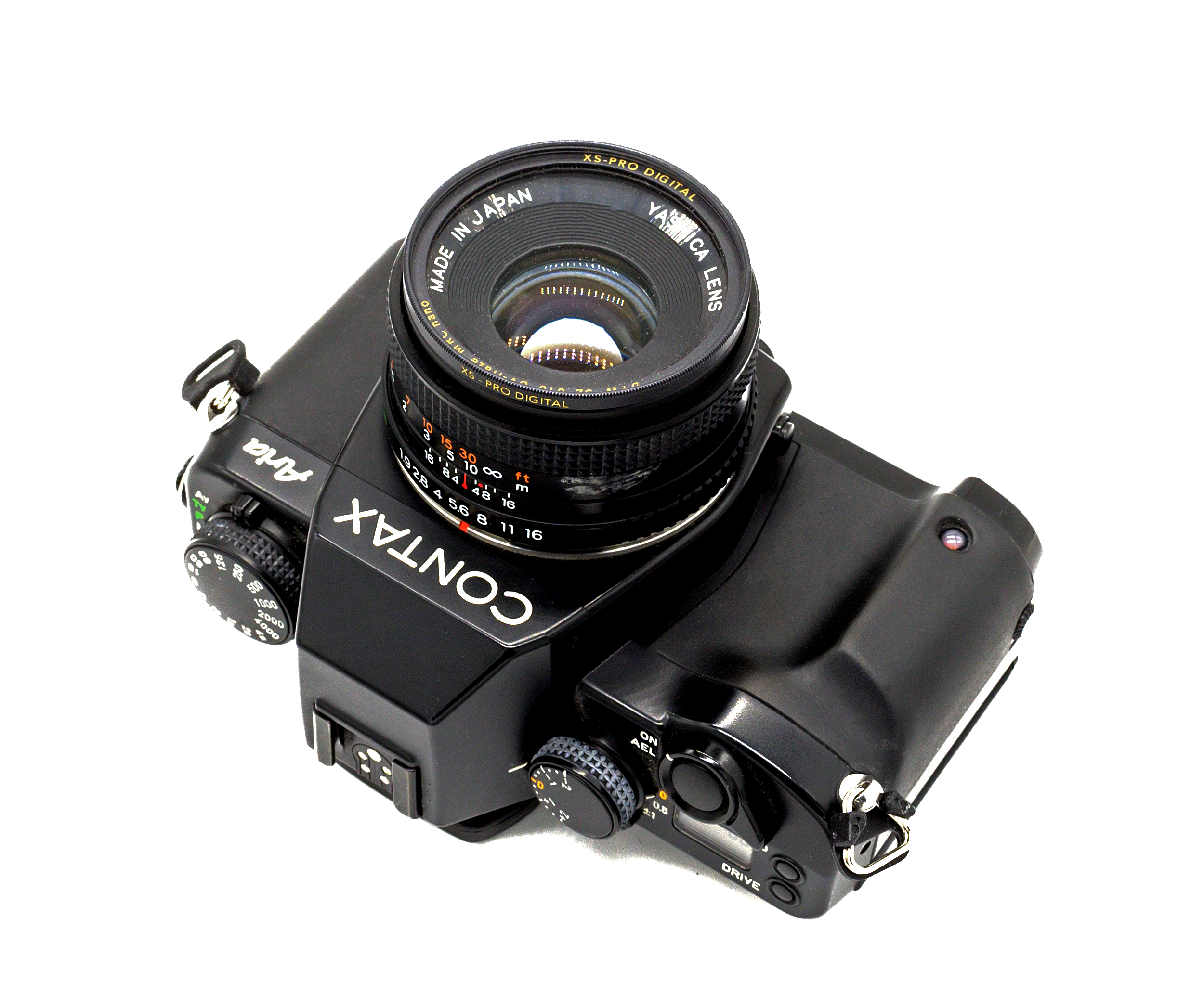
The Contax Aria is one of my favorite 35mm film SLRs. With its bright viewfinder, a 1/4000 top shutter speed, integrated motor drive, lightweight construction, capability of using the latest Contax TTL flashes, and multiple metering modes, it checks all of the boxes. It’s a little pricey but worth it.
The 1998-2004 Aria was the last “new” manual-focus 35mm film SLR produced by Kyocera under the Contax brand name (for the purposes of this statement, we are going to exclude the later de-featured RXII). Contax would only release two more new 35mm film SLRs afterwards: the autofocus models N1 (2001) and NX (2002). Unfortunately, neither of these later autofocus bodies are compatible with C/Y lenses. Not designed or marketed as a professional’s camera, the Aria’s main attraction is that is light, so light in fact that almost all of the great Contax SLR lenses make the camera decidedly front heavy. The Aria pretty much combines everything a regular person would want in a film SLR.

When autofocus technology substantially improved during the early 1990s, most major manufacturers abandoned the concept of the advanced manual-focus SLR with integrated motor drives. One would have to go back to 1990 to find the last similar model produced by Nikon, the extremely underwhelming F-601M (the N6000), a manual focus version of the F-601 (N6006). For Canon, we would have to go all the way back to the 1986 T90. By the 1990s, only Leica and Contax were producing high-quality, professional-level, manual-focus 35mm film SLRs.
Specifications
| Lens Mount | Contax/Yashica |
| Shutter | Vertical Metal Focal Plane |
| Shutter Speeds | B, 16 sec – 1/4000 (P/A); 4 sec – 1/4000 (Shutter/Manual) |
| Flash Sync | 1/125 |
| Exposure Modes | Program / Aperture / Shutter / Manual |
| Metering Modes | Matrix / Center-Weighted / Spot |
| ASA | DX (25-5000); Manual (6-6400) |
| Exposure Compensation | + 2 EV to – 2 EV in 1/3 Increments |
| Viewfinder Coverage | 95%; 0.82x. |
| Batteries | 2 x CR2 Lithium |
| Motor Drive | Up to 3 FPS in Continuous |

Operation
The Aria has extensive functionality for a non-professional SLR body. Over the Aria, the professional RTS III has only the following real-world advantages: (1) better viewfinder coverage and brightness; (2) a more powerful internal motor drive; (3) built-in viewfinder diopters; (4) a 1/8000 top shutter speed; and (5) a 1/250 flash sync speed.
Light! One of the main draws of the Aria is its size and weight, only 460 grams (without the batteries). A Leica M7 body is 610 grams. A Contax 167MT body is 620 grams. A Nikon F4 body is 1280 grams. An iPhone 13 Pro Max is 240 grams. The body is so light that any of the professional C/Y lenses will often double the weight of the set up (the 50mm f/1.4 is 330 grams, the 85mm f/1.4 is 595 grams, and the 35m f/1.4 is 600 grams). The Aria’s diminutive package makes it great candidate for a camera you could easily slug around all day, whether it be at a party, on a hike, or vacation, whatever.
Metering Modes: The Aria has three separate metering modes (spot, center, and full) adjustable via a switch on the back of the camera. The selected mode is visible in the viewfinder. These work reasonably well. I find that in non-straightforward lighting situations, the full view errs on the side of underexposure. The Aria’s metering is good but certainly not as sophisticated as, say, Nikon’s matrix-metering system.
Integrated Motor Drive: The Aria has an integrated motor drive that can automatically load, advance, and rewind the film. The advance has two setting: single and continuous. The “continuous” mode apparently can achieve up to 3 frames per second in absolutely ideal conditions.
Exposure Modes: The Aria has five exposure modes: program, aperture-priority, shutter-speed-priority, metered manual, and TTL auto flash. These are set via a dial on the upper left side of the camera.
Reasonably Bright Viewfinder. The Aria’s viewfinder brightness is pretty good, far better than most consumer SLRs that came before it, but not quite “professionally good.” It is on par with cameras like the older Contax 137MA and just slightly darker than the RTS II. The right side of the viewfinder displays: (1) the shutter speed; (2) the selected aperture; (3) a metering mode icon (blinking if locked); (4) the frame count; (5) a flash-on icon; (6) a “M” or “X” if set to either mode; (7) exposure compensation marks; and (8) over/under exposure warning indicator.
The Aria can use four different focusing screens, the same ones used by the 167MT. I believe the FU-4 is the standard screen.

Quiet Operation. The motor drive is not silent by any means, but it is quiet. Most likely the quietest of all Contax SLRs.
AE Lock Functionality: Like most other Contax bodies, the Aria’s exposure lock is activated by metering the scene and then switching the top lever from “On” to “AEL.” The AEL setting will hold the metering forever until the switch is toggled back to “On.” However, the Aria permits you to set a Custom Function where a half-press of the shutter button will lock the exposure. The other four Custom Functions include: (1) switching the automatic bracketing mode from regular-over-under to over-regular-under; (2) altering the rewind function to prevent the leader from being rewound; (3) overriding the automatic rewind at the end of the film; and (4) overriding the advance to the first frame when loading the film.
Lens Compatibility. The Aria can use any Contax lens designated “MM” in all exposure modes (“MM” lenses are easily identified by their minimum aperture in green paint). Older Contax “AE” and Yashica lenses can be used in aperture-priority or manual mode.
Other Features: The Aria has a number of other interesting features, including: (1) a depth-of-field preview button; (2) an auxiliary shutter release on the side of the lens, (3) automatic exposure bracketing; and (4) exposure compensation dial (+/- 2 stops)
D-9 Data Back. A holy grail-type accessory, the D-9 data back can, among other less impressive functions like “interval shooting” and the imprinting of the exposure data either as a list on a frames of the film roll itself or between the frames. Today, these are pretty hard to find unless you can purchase an body with one already attached. I believe that the D-8 (AX), D-9 (Aria), and the D-10 (for the N series) were the only Contax data backs that could do exposure imprinting.
Flash Stuff. Flash sync at 1/125 is ok for this class of camera. All TLA series Contax flashes will work in TTL mode with the Aria, but only later flashes with five pins can take advantage of rear curtain sync. With TTL-capable flashes, the Aria can perform a pretty good automatic daylight fill. And dialing down TTL flash compensation is very easy by using the exposure compensation dial to cut or increase the relative flash power.

Versus Other Contemporary Higher-End Manual Focus SLRs
If the Aria had any direct contemporary competition in the higher-end, small-body, manual-focus SLR market, it would have been the Leica R7 and the Nikon FM3a. Here are the three compared.
Specifications
| Contax Aria | Nikon FM3a | Leica R7 | |
| Years Produced | 1998-2004 | 2001-2006 | 1991-1996 |
| Shutter | Electronic Metal Focal Plane | Hybrid Focal Plane | Electronic Metal Focal Plane |
| Shutter Speeds | B, 16 sec – 1/4000 | B, 8 sec – 1/4000 | B, 16 sec – 1/2000 |
| Flash Sync | 1/125 | 1/250 | 1/100 |
| Exposure Modes | P / A / S / M | A / M | P / A / S / M |
| Metering Modes | Matrix / Center / Spot | Center | Matrix / Center / Spot |
| ASA | 6-6400 | 12-6400 | 6 – 12800 |
| Exposure Compensation | + 2 EV to – 2 EV | + 2 EV to – 2 EV | + 3 EV to – 3 EV |
| Viewfinder Coverage | 95% / 0.82x | 93% / 0.83x | 92% / 0.80x |
| Batteries | 2 x CR2 Lithium | 1 x CR1/3N | 2 x CR1/3N |
| Drive | Integrated Load / Advance / Rewind | External MD-12 | External Motor Drive R |
| Weight (Body) | 460g | 570g | 670g |
Although the R7 and FM3a are both excellent camera bodies, neither of them really overall outclass the Aria. Although R7 bodies are not terribly expensive today, used Leica R lenses are in the running for the most overpriced items in 35mm photography today. And it is far from clear whether Leica R lenses perform objectively better than their Contax equivalents. The now-pricey Nikon FM3a is indisputably a masterpiece of late film SLR design; but most Ai-S lenses are not in the same performance league as Contax or Leica R glass. Given the price of the bodies, the relative capabilities of the cameras, and the price-to-performance ratio of the desirable lenses, I would still take the Aria over the R7 or the FM3a.
Conclusions
The Aria is a fantastic little SLR that checks all the boxes: lightweight, a fast top shutter speed, a reasonably quick motor drive, multiple metering modes, all of the standard exposure modes, and an above-average viewfinder. The Aria is a far superior and more capable tool than any of the older non-professional Contax bodies like the 139, 137, 159MM, or the 167MT. The Aria is a little pricey for a manual-focus SLR, but entirely worth it. If looking to save a few bucks, maybe look at the Contax RX, which has the same essential feature set but in a larger and heavier package.